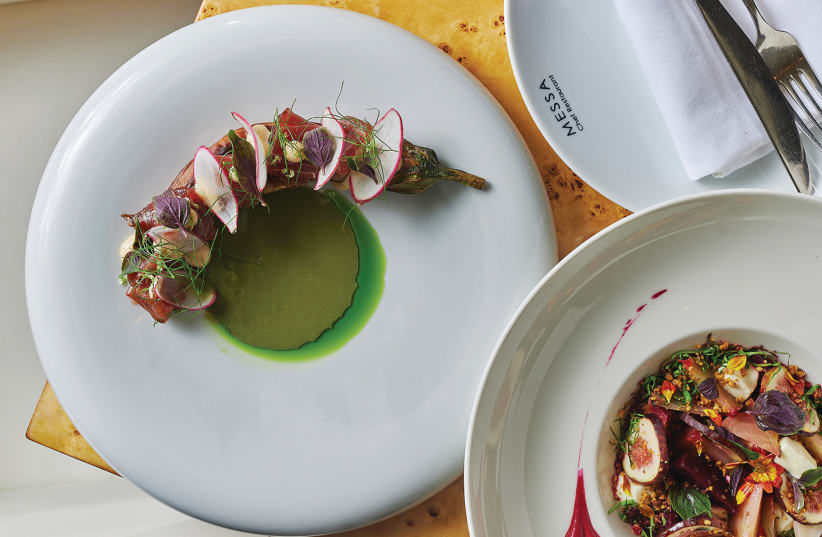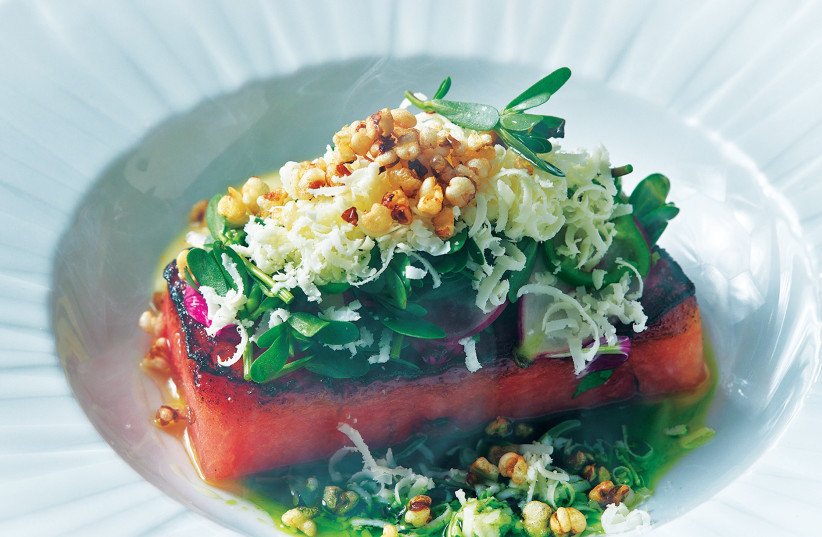For years, the prestigious restaurant Messa was associated most closely with its talented chef, Aviv Moshe. Then came COVID, which shuttered the restaurant for the better part of a year. During that time, Aviv embarked on other pursuits (a Japanese fusion restaurant and events catering); so when the owners decided to reopen, they went on a talent hunt for a new chef, eventually tapping Asaf Shtern, whose resume includes years of training in Michelin-starred restaurants in Europe.
Aside from the shake-up in the kitchen, little appears changed in the restaurant’s decor. It is sumptuously accessorized with leather chairs, sofas and rows of plush pillows that look impressive – but the whole place is the epitome of form over function. For example, it is not always easy to find a table with chairs that harmonize ergonomically; one table had three different kinds of chairs, each at a different height in relation to the eating surface.
In addition, the oversized hanging lampshades so obscured the lighting that the result was a dimness that made menu-reading difficult, without adding to any air of intimacy. And the paper napkins instead of cloth detract from the aura of exclusivity that the expensive restaurant endeavors to project.
We began by ordering two of Messa’s specialty cocktails (NIS 58-62) as we prepared to peruse the menus. We thought we had ordered them in plenty of time to enjoy sipping before starting to eat; but the waitress appeared eager to take a food order, and the cocktails took so long to arrive that they were served practically at the same time as our first course.
This is not to detract from the taste of the house cocktails. We enjoyed both the vodka-based Full of Passion and the gin-based Sunset (not listed on the printed menu), which came cold and refreshing – tart in the case of the former, sweet in the case of the latter – in martini glasses.
There are separate Hebrew and English food menus, the latter marred with occasional free translations that played fast and loose with the Hebrew descriptions – and the actual dishes – not to mention the strange rules of capitalization and (acceptable level of) typos. (Warning: The online English menu is hopelessly out of date.)
The two menus are nonetheless alike in the number of categories: Starters (NIS 38-42), First Courses (NIS 64-112) and Main Courses (NIS 98-218). There are very few vegetarian options, and even fewer vegan ones.
The house bread (NIS 32, listed as a starter) is actually a basket containing three types: soft breadsticks, a dark sourdough with nuts and French bread. They are accompanied by three dips: a tasty burnt zucchini pesto, a mild harissa and an ordinary mix of olive oil with balsamic vinegar.
We chose our entrees not from among the starters but rather from the section of first courses. First was the Red Tuna on Japanese eggplant in nori powder, green Thai sauce, ground peanuts, baby green leaves and Asian aioli. There is a lot going on in this beautifully presented dish, yet ultimately the combination of ingredients ends up enhancing the fresh raw fish admirably.
Next was the Foie Gras Scallopine atop gnocchi a la Romana, in a port wine sauce. The gnocchi are actually small cakes of semolina pasta, on which are extremely thin slices of gently fried foie gras and tiny dabs of carrot and saffron cream. In spite of the too-thin portions of foie gras, and the meager contribution of the orange-colored cream, the dish as a whole was terrific: the rich goose liver melted in the mouth, paired nicely with the crusty semolina squares.
We began our main courses with the Seafood and Saffron Risotto in sage butter and white wine, with pepper, corn and Parmesan cheese. The generous dish was dominated by crab and calamari, making it all the more disappointing when we could find only one measly (albeit plump) shrimp amidst the rice. Still, the risotto overall was absolutely delicious.
Finally came the Lamb Chops – three delicate chops on a bed of potato cream, with roasted bok choy, zucchini and leek stuffed with burghul in a tamarind sauce. The last was the standout side dish, while the main event – the lamb chops on the bone – were marbled and succulent (even if the demi-glace was superfluous).
As expected in a pretentious restaurant, the thick leather-bound wine list boasts an extensive selection of international vintages. Unfortunately, there is not a word in English, even though it is so easy simply to copy what is written on a label. There is a barely adequate number of wines available by the glass (NIS 45-170).
The service was friendly enough, but rather spotty. Our main courses arrived with no serving spoons, and we had to wait quite a while after the arrival of our main courses to receive our two glasses of wine.
The separate bilingual dessert menu features five elaborate creations (NIS 48-68) by dedicated pastry chef Morag Cohen. We settled on only one: the Exotic Cheese, described as cheesecake, but more like a mascarpone mousse, with white snow icing and surrounded by passion fruit caviar and mago salsa, embellished additionally with a scoop of ricotta ice cream and an ketura helping of passion fruit sauce poured at the table. It was light, sweet and an ideal last course. MessaNot kosher 19 Ha’Arbaa St., Tel Aviv.Tel. (03) 685-6859 The writer was a guest of the restaurant.

